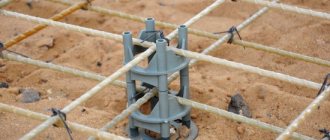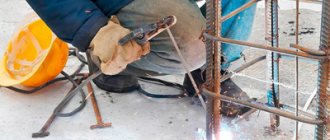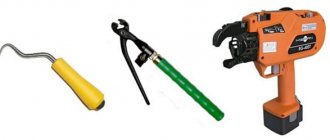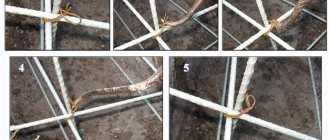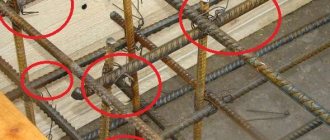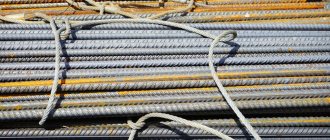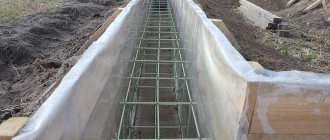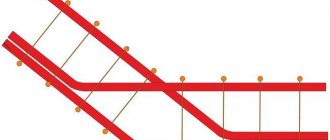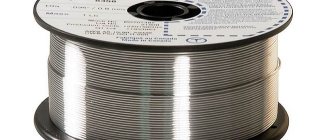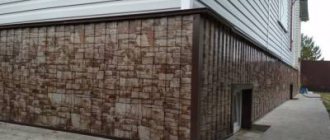Basic cutting options
Working with a hacksaw on metal
When preparing material on how to cut reinforcement, it was necessary to analyze many recommendations published on the pages of Internet forums on this topic. The results of the study were ultimately reduced to the following main cutting options:
- working with a regular hand hacksaw;
- cutting using hand-held metal shears (with hydraulics), so-called “bolt cutters”, which can be used for reinforcement diameters of no more than 6-8 mm;
- using a cutting torch;
- cutting reinforcement using a grinder (angle grinder) with discs for concrete.
Hand hacksaw
Some forum visitors even suggest using powerful hydraulic shears, which are equipped with rescue services.
Strengthening foundation structures
When used to reinforce strip and other types of fiberglass foundations, rods with a diameter of 8 mm are used, which is equivalent to the use of 12 mm steel reinforcement.
Calculations for replacing steel reinforcement with fiberglass
It is not difficult to carry out the procedure for such reinforcement with your own hands, if you adhere to the following algorithm.
- When installing the formwork, it is recommended to wrap its elements with parchment, which will allow them to be reused.
- On the inside of the formwork elements, using a horizontal level, mark the line up to which the concrete solution will be poured. This procedure will allow the concrete solution to be more evenly distributed throughout the entire internal volume of the future strip or any other foundation.
- The reinforcement elements with which you will strengthen your foundation must be covered with a layer of mortar at least 5 cm thick. In order to maintain this distance, you can use ordinary bricks that are laid on the bottom of the future foundation.
- Two rows of reinforcement are placed on the bricks laid at the bottom of the future foundation. In this case, it is desirable that solid rods be used, without joints. By measuring the length of the sides of the foundation being poured, you can easily determine how long the rod you will need to unwind and cut from the overall coil.
- After laying the longitudinal reinforcement bars, it is necessary to attach transverse jumpers to them, which are fixed with plastic clamps.
- Then you need to make the upper level of the reinforcement cage, which should be identical to the lower one. Both levels of such a frame, the cell dimensions of which should be approximately 150 mm, are connected using vertical jumpers.
- After making the reinforcement frame, they begin pouring the concrete solution. It is up to you to decide what concrete mixture will be used for this, but preference is most often given to the M400 brand solution.
Reinforcement of the foundation belt with fiberglass reinforcement
To quickly and continuously pour the foundation, it is better to use the services of a mixer
It is not difficult to calculate how much mortar you will need to fill the foundation: to do this, you need to calculate the perimeter of the future foundation, and then multiply the result by its width and depth
When pouring concrete mortar with your own hands, it is important not to forget that it must be compacted periodically so that air bubbles do not form in the foundation mass
It will take 2-3 weeks for the poured concrete solution to completely harden. During this period, the poured foundation must be covered with a film from rain, and if the weather is hot outside, its surface must be periodically moistened with water.
Cutting composite reinforcement with an angle grinder (“grinder”)
Like everything in the world, this method has its pros and cons.
Advantages of cutting composite reinforcement with a grinder
- cutting speed of the bar - you will make it quickly enough (the fastest of the proposed methods); — the ability to cut several rods at once; - low labor costs; — it is possible to use any disc (for metal, for stone, diamond, grinding).
Disadvantages of cutting composite reinforcement with a grinder
— when cutting reinforcement with an angle grinder, the cut is made by a disk rotating at high speed. Therefore, when cutting, a stream of fiberglass dust flies from under the disk, which then hangs in the air for a long time. The cooling system of a power tool (blowing) only increases this moment. Therefore, cutting with a grinder must be done using protective equipment, such as goggles, gloves, and a respirator. It is better to carry out work outside; — working with a grinder, like any other type of power tool, is possible only if there is a working electrical outlet in the area where the work is being done.
Leading manufacturers
The production of composite fiberglass reinforcement is carried out in many regions of our country. This especially applies to areas with developed industrial infrastructure, such as:
- Moscow and the Moscow region - "Moscow Composite Materials Plant", LLC "NPC "SPETSPOLIMER", LLC NPK "ARMASTEK" and others;
- St. Petersburg and Leningrad region - “Leader-Composite” and others;
- Yaroslavl - “Yaroslavl Composites Plant”;
- Ekaterinburg and Sverdlovsk region - Uralteplostroy, UZKT LLC, Elpromtekh LLC, NPF UralSpetsArmatura LLC;
- Saratov - LLC "Povolzhskaya Armatura" (Polarm).
A wide range of SPA allows you to choose not only by technical characteristics, but also by the form of implementation
Differences in fittings
In addition to length, metal rods can differ from each other in their diameter and class (from A-1 to A-7).
The higher the class of reinforcement, the more durable it is considered.
The easiest way to visually identify class A-1 reinforcement is that it has a smooth surface. The remaining classes (from A-2 to A-7) are periodic profile rods. All fittings of the above classes are hot-rolled.
If the metal rods have been hardened by thermomechanical treatment, the letter “t” will appear in their designation: from At-3 to At-7.
Specifications
Glass reinforcement appeared in the 1960s. Due to its high cost, it was used exclusively in the Far North, where metal structures were quickly exposed to corrosion. Composite materials were most often used to construct bridge supports. Thanks to the rapid development of the chemical industry, the price of fiberglass reinforcement has greatly decreased. This made it possible to become an affordable product that shows only its good side in all building structures for various purposes.
The wide popularity of glass fittings contributed to the development of GOST 31938-2012, which outlines the requirements for the manufacture of fittings and methods for testing them. In accordance with this state standard, composite fiberglass reinforcement is manufactured with a diameter of 0.4 to 3.2 cm. However, materials with a diameter of 0.6 are in great demand; 0.8 and 1 cm.
Fiberglass material consists of high-strength rods of various diameters. They are made of composite material – fiberglass. They are mainly used in concrete structures, as well as for installation instead of iron reinforcement. Fiberglass can be painted, decorated, covered with PVC films, and can also be subject to all types of mechanical processing. Depending on the reinforcing additive, glass-composite, carbon-composite and combined glass reinforcement are distinguished.
When choosing glass reinforcement for installing the foundation of a structure, it is necessary to take into account such technical characteristics as:
- the upper temperature limit for the use of glass fittings is more than +60ºС;
- Ultimate tensile strength is the ratio of the applied power to the cross-sectional area of the part. Fiberglass composite reinforcement has an ultimate strength of 900 MPa, and carbon composite reinforcement - 1400 MPa;
- tensile elasticity for carbon composite materials is 3 times higher than for glass composite materials;
- the ultimate strength during compression for any type of glass reinforcement must be above 300 MPa;
- the ultimate transverse shear strength for glass reinforcement must be at least 150 MPa, and for carbon composite reinforcement – at least 350 MPa.
Rebar cutting tool
The best way to cut reinforcement depends on its diameter and class. The smaller they are, the easier it is to handle the metal rod.
Therefore, for cutting A-1 reinforcement (with a diameter of up to 10-12 mm), ordinary bolt cutters are also suitable (they are also called rebar shears or rebar cutters). With their help, you can handle a small number of rods quite easily, since the force you apply is increased due to the double lever system working in them.
We recommend reading: Pile foundation: pros and cons, reviews of pile foundations
For cutting thicker and more durable reinforcement, a grinder is more suitable. Its main advantages (light weight and power) allow you to work quickly, and since you can use it to cut reinforcement wherever there is space and there are no flammable materials nearby, it is what craftsmen usually give preference to.
Another option is a special guillotine for reinforcement (for example, EDMA RODCUT 0659). This device greatly facilitates the process of cutting reinforcement into pieces of a certain length. True, a guillotine is quite expensive, so it is usually purchased by specialized companies, and not by those who like to build something with their own hands.
You can also use a special machine for cutting reinforcement, which greatly facilitates and simplifies the entire process.
Calculation procedure for building structures with composite reinforcing materials
The process of calculating structures in which composite reinforcement is used can be demonstrated by the example of calculating the work of a beam using steel reinforcement D12 mm.
Such reinforcing rods A500C, having a diameter of 12 millimeters, have the following characteristics:
- The elastic modulus value is at 200 GPa;
- The standard resistance indicators are 500 MPa, which is slightly less than the fluidity parameters of the steel used in the manufacture of these rods.
Based on these data, the estimated maximum load on the rod is 4.5 tons. With such a load, the tensile parameters of the reinforcement will reach 2.5 mm/m
In the documentation that comes with fiberglass reinforcement, there is always a sign indicating its compliance with steel reinforcing rods.
Thus, fiberglass reinforcement, to comply with the parameters of steel A500C with a diameter of 12 mm, must have a diameter of 10 mm.
In other words, the process of calculating buildings with plastic rods is completely similar to calculations with steel rods, the only difference is the use of a correspondence table.
How to cut rebar correctly and safely
If you decide to cut reinforcement with a grinder, do not forget to take care of your safety:
- firstly, remember about special glasses, comfortable work gloves and appropriate clothing;
- secondly, the reinforcement that you are going to cut must be raised above the surface (above the ground) so that the grinder disk does not catch on it;
- thirdly, the reinforcement to be cut must be secured (or simply held so that it does not move while you cut it - for this you will need an assistant).
Video description
Getinax, textolite, fiberglass, ebonite: properties, processing.
The main thing when cleaning the edges is not to overdo it and make sure that the edges have strictly straight sides.
Circular saw for cutting various layers of fiberglass Source onlinetrade.ru
On a note! When trying to cut PCB yourself, it is important to use only high-quality and well-sharpened tools. Rusty, oxidized cutting objects will not allow you to get a perfect result.
The most convenient and reliable way to cut textolite is on a machine Source foromadera.com
Cutting upon purchase
If you buy reinforcement in a store or warehouse in small quantities, ask workers to cut it into pieces of the length you need right there. Typically, many sellers provide this service (for a fee or free of charge), trying to attract as many buyers as possible, since cutting reinforcement in this “method” is much more profitable:
- you don’t have to look for a car and transport long reinforcement bars;
- the reinforcement will arrive at your construction site already cut into pieces of the required length, and you can immediately start working with it;
- you do not need to cut the reinforcement yourself and look for the necessary tools for this.
Just remember to calculate in advance the number and length of reinforcing bars you need.
Drilling
When drilling holes with drills with a cutting part made of hard alloys, the cutting speed can be increased by 2-2.5 times.
To avoid delamination of laminated plastics, the following conditions must be observed: good fastening of the material being processed, its tight fit to the supporting surface, the use of pads. good chip removal.
In all cases, it should be taken into account that due to the springing of the laminated plastic material, the diameter of the hole is 0.01-0.05 mm smaller than the diameter of the drill.
Thread cutting.
For cutting external threads, thread-cutting heads with round combs are used. Taps are used to obtain internal threads. The tool must be made of high-speed steel with a wide and round tooth profile and a sharpening angle of 60°. To remove chips, taps must have three grooves. 'The feather should not be wide to avoid increased friction and clogging of the groove with chips.
Cutting edge angles: front γ= 15°, rear ά=5-8°. When cutting threads, the threading tool is lubricated with oil, beeswax, talc, etc.
Grinding
The feed depends on the required purity of processing and ranges for getinax and textolite from 0.1 to 0.5, and for fiberglass from 0.05 to 0.25 mm/revolution. In this case, it is possible to obtain 4-6 classes of cleanliness.
The cutters have a rake angle of 10-15°, a back angle of 8-10° for high-speed steel; rake angle 1 -15° and back angle up to 34°, provided that a tip made of hard alloys is used.
Planing
When planing, cutters made of high-speed steel or with a carbide tip of the same brand as those used for turning are used. The rake angle of the cutter is 15°, the back angle is 10° with a cutting edge angle of 6°. Feed 0.2-0.6 mm, cutting speed for high-speed steel cutters 15-20, for cutters with a carbide tip 30-40 m/mm.
Milling
The cutting tools used are standard cutters made from high-speed steel for getinax and textolite and from hard alloys (VK-ZM) for fiberglass.
Cutting angles: front 8°, front angle f = (45°, rear angle a = 20n-25°. Feed 0.05-0.25 mm/tooth. Cutting speed with high-speed steel cutters for textolite and getinax 100 -200, for fiberglass 80-30 m/min. When using hard alloys, these speeds can be increased by 1.5-2 times.
Stamping, cutting and punching
Stamping, cutting and punching.
To successfully carry out these operations, it is necessary to use stamps with tight pressure on the sheet and product at the working moment. The cutting edges of the punch and matrix must be sharp, and the gap between the punch and the matrix hole should not exceed 10-15% of the sheet thickness (the best results are obtained when this gap does not exceed 0.025-0.05 mm).
The taper of the punch for its removal in order to avoid the formation of material separation (“halos”) is recommended to be maintained at 5° (relief angle). The material of the sample is U-9 carbon steel, which has a hardness after hardening and tempering of Rc = 54-56.
When cutting out rectangular holes, sharp corners must be rounded with a radius of at least 0.5 mm. The diameter of the stamped hole, as a rule, should not be less than the thickness of the material. The distance of the cut-out hole from the edge, as well as the distance between the cut-out holes, should be at least 2-3 times the thickness of the stamped material.
Laminate stamping ability
is directly dependent on the relative elongation that the material is capable of upon instantaneous rupture.
At the same time, the ability of laminates to spring should be taken into account. In this case, springing ranges from 0.02 to 0.13 mm (for fiberglass, getinax and textolite).
How to cut composite reinforcement
One of the main advantages of composite reinforcement is the simplicity of its cutting. Cutting of fiberglass reinforcement is carried out directly at the work site, which significantly reduces construction time. To cut rods to size, use the following tools:
- axe;
- bolt cutter;
- hacksaw for metal;
- angle grinder.
Let's look at the advantages and disadvantages of each tool.
Angle grinder
When the question arises of how to cut fiberglass reinforcement for the foundation (we have already written in more detail about the material itself here), builders first of all remember the grinder. This tool allows you to cut a large amount of material efficiently, quickly and with minimal effort.
The advantages of using an angle grinder include:
- high speed;
- using a grinder you can cut a bunch of rods at once;
- mechanized cutting does not require much muscle strength;
- possibility of using discs with any cutting edge (for metal or stone).
We recommend reading: Which is better USHP or strip foundation
Before cutting fiberglass reinforcement with a grinder, you need to take into account the disadvantages of working with this tool:
- It will not be possible to cut fiberglass with a grinder without dust. The high speed of rotation of the disk leads to the spraying of small particles of fiberglass into the air. Using an air blower to cool the tool's motor further spreads the composite dust. Therefore, when working with an angle grinder, you need to use eye and respiratory protection, especially if you are cutting reinforcement indoors;
- To operate an angle grinder, you must have an electrical connection point.
In general, the disadvantages are quite trivial.
Hacksaw for metal
If you only need to make a few cuts, you can use a regular hacksaw.
The use of hand tools provides the following advantages :
- Every owner has a hacksaw for metal. This is the easiest and cheapest way to cut a small number of rods for a bundle of reinforcement cage;
- no spraying of small particles, as is the case with an angle grinder.
Disadvantages of using a hacksaw for cutting composite reinforcement:
- low speed;
- high load on the employee if it is necessary to perform a large amount of work;
- Possibility of use only in individual construction with small volumes of work.
Bolt cutter
Before cutting composite rebar with a bolt cutter, you should also learn the pros and cons of working with this tool. You need to understand that the bolt cutter does not cut the composite rod, but rather cuts it, which affects the technical characteristics of the material.
Benefits of using a bolt cutter:
- no electrical connection required;
- When working with a bolt cutter, a large number of small particles are not formed, so rods can be prepared to size indoors;
- With a bolt cutter in your hands, you can move and work anywhere (no wires).
Disadvantages of using a bolt cutter:
- using a bolt cutter, you cannot cut more than 3 rods at the same time;
- when working with this tool, it is necessary to use significant muscle effort;
- A bolt cutter is rarely on the list of household tools. To operate, you will have to rent or buy it, which is not economically feasible;
- the use of a bolt cutter causes deformation of the material at the cut site (crumbs of material and longitudinal cracks appear at the end of the rod). Such deformation reduces the load-bearing capacity of the reinforcement and shortens its service life.
Axe
If funds are limited, an ax can also be used to prepare the reinforcement. It, like a bolt cutter, cuts the rod, which affects the condition of the reinforcement at the point of cutting.
Positive points:
- Every owner has an axe. There is no need to purchase the tool separately;
- speed. When preparing the base for cutting reinforcement, the work can be completed quite quickly.
Negative points:
- inaccuracy of the cut. Not every master can accurately and strongly hit the right place with an ax to cut a composite rod;
- deformation of the tip of the rod. During operation, water, cement, and alkali can get into longitudinal cracks, which will lead to a violation of the technical characteristics of fiberglass and weakening of the entire structure. With temperature changes, the split reinforcement inside the product will change in volume, which will lead to the destruction of concrete.
Reinforcement technology
When reinforcing various types of foundations, reinforcement bars with a diameter of 0.8 cm are used.
When performing installation yourself, you should adhere to the following sequence:
- when installing the formwork, its parts are wrapped in parchment paper so that they can be used several times;
- Using a horizontal level, markings are made on the formwork parts to which the concrete solution will be poured. This is necessary for uniform distribution of the concrete composition along the entire perimeter of the foundation;
- glass reinforcement elements for strengthening any types of foundations are covered with a mixture more than 5 cm thick. For this, you can also use bricks, which should be laid on the bottom of the structure;
- Several rows of fiberglass reinforcement are placed on a row of bricks. Solid rods with no joints should be used. To calculate the required length of the rod, you must first measure the length of each side of the future foundation. Based on these values, you can unwind or cut the rods to the required length;
- after laying the longitudinal row of rods, they proceed to strengthening the transverse jumpers with plastic clamps;
- The upper part of the frame is made, which exactly repeats the lower part. The size of one cell is about 15 cm. Both levels are fixed with vertical jumpers;
- After knitting the reinforcement frame, the process of pouring the concrete composition begins. Experts recommend using concrete grade M400.
Proper calculation of fiberglass reinforcement will allow you to avoid unnecessary costs and additional problems due to a lack of reinforcing bars and purchase the required quantity of the product. The calculation for strip and slab foundations consists of determining the length and number of rods based on the area of the foundation and the pitch of the reinforcing mesh
It is necessary to take into account that the slab must have two reinforcing belts: lower and upper, which are secured with vertical rods along the entire perimeter of the slab. The process of reinforcing a columnar foundation occurs differently
Ribbed reinforcement is reinforced vertically, and smooth reinforcement is reinforced horizontally. The frame requires 3–4 rods, their length equal to the height of the pillar. For pillars of large diameter, a larger number of rods will be needed, and more than 4 horizontal rods are needed per pillar.
The concrete solution hardens in about 3 weeks. At this time, you need to protect the surface of the poured foundation with polyethylene from moisture. In sunny weather, it is recommended to spray the surface with water.
Most professionals argue that when laying gas and foam blocks, corners should be reinforced with metal reinforcement. This combination will give building structures even greater strength, stability and reliability. Disputes often arise about the need to knit glass reinforcement with plastic clamps. Knitting should be done to strengthen the reinforcement frame before pouring the concrete mixture until the composition dries completely. After the surface hardens, it no longer matters whether the frame is connected or not.
In the video below you can see a review of fiberglass reinforcement for the foundation.
Recommendations for cutting composite reinforcement
Before cutting plastic reinforcement with your own hands, you should familiarize yourself with the safety precautions when performing work.
We recommend reading: What is the best way to make a floor in a bathhouse - choosing the appropriate option
When working with electromechanical tools, the following protective equipment must be used:
- respirator. Small composite particles spread quickly in the air, especially if work is carried out indoors. To protect the respiratory system, it is necessary to wear a respirator and carefully adjust it to the size of the face;
- protective glasses. When cutting fiberglass with an angle grinder, small particles often fly off. Getting such particles into the eyes is fraught with damage to the integrity of the cornea and inflammatory processes. Therefore, protect the eyes with a mask or special glasses;
- gloves with a latex layer will protect the skin of your hands from small particles of fiberglass.
Devices for bending reinforcing bars
Quite a lot of devices and simple machines that allow you to bend any reinforcement with your own hands have been invented. All such devices operate on a similar principle, and their differences lie in the design and technical characteristics, the most significant of which is the largest diameter of the bending rod.
Operating principle of reinforcement bending machines
The reinforcement that needs to be bent is fixed on such a machine between two rollers: central and thrust. The bending process itself is carried out due to the influence of the third roller on the rod, which is called the bending roller. By acting on the rod during bending (it can be done either clockwise or in the opposite direction), the bending roller allows you to obtain the required bending angle on the product. The thrust roller or shaft performs a limiting function; thanks to it, the reinforcement is not deformed along its entire length, but only in the place where it is required to form a bend.
Today, two categories of such machines are used:
- manually operated devices;
- mechanical drive models.
Manual machines for bending reinforcement
The design diagram of machines equipped with a mechanical drive is as follows. A disk is mounted on the device shaft, located vertically, on the surface of which the central and bending fingers are fixed. The roller against which the reinforcing bar rests during the bending process is fixed on the machine stand. Reinforcement using such a machine is bent according to the following scheme: the rod is placed between the central and bending fingers; When the disk rotates in a horizontal plane, the rod rests against the thrust roller and, under the influence of the bending pin, begins to bend around the central roller. During the bending process, the bending finger moves along the outside of the bend being formed.
The machines, the design of which is described above, may differ from each other in their power and performance, and according to their purpose they are divided into three main categories:
- models for bending light reinforcement with a diameter of 3–20 mm;
- devices for working with heavy reinforcement (20–40 mm);
- models for bending extra-heavy reinforcing bars (40–90 mm).
Reinforcement bending machine PF32
On machines belonging to the latter category, several reinforcing bars can be bent simultaneously. On the modern market you can also find universal equipment, the technical capabilities of which allow you to bend metal rods in the diameter range of 3–90 mm. If desired, you can find a device with a hydraulic drive, with the help of which complex reinforcement structures with variable bending angles are obtained and even a ring is formed from a metal rod.
The use of such equipment allows you to make very high-quality bends, the angle of which can reach up to 180 degrees. The surfaces of workpieces that have been bent on such equipment do not have folds or kinks, and there is no metal stress in their internal structure.
The small-sized machine is easy to carry and secure at the work site
There is a fairly large assortment of manual bending devices on the market, including both portable and larger models. To bend reinforcement at home, you can purchase either a specialized manual device or a pipe bender. Such simple devices, which allow various bends of reinforcing bars whose diameter does not exceed 14 mm, are mounted on the surface of a desktop or workbench. This option is quite suitable for equipping a home workshop, but if you need to perform large volumes of work on bending reinforcement, it is better to purchase a more serious machine.
The choice of equipment with which reinforcement can be bent at home is mainly influenced by two factors: the diameter of the rods and the amount of work that you need to do. When bending, different parts of the reinforcing bar are subjected to loads of different directions: the outer surface of the bend is in tension, the inner surface is in compression. Such loads, if the machine is incorrectly selected and configured, can lead not only to the appearance of defects on the surface of the rod (kinks and folds), but also to its destruction. That is why you should choose a bending machine taking into account all the characteristics of the reinforcement that will be processed on it and the parameters of the bends being formed. Correct setting of the machine is also of great importance for performing high-quality bending of reinforcement.
Cutting composite reinforcement with a hacksaw
Advantages of cutting fiberglass reinforcement with a hacksaw
- the tool is cheap and available in almost every household.
Advantages of cutting fiberglass reinforcement with a hacksaw
- slow cutting; - high labor costs; — it is advisable to use for small volumes of work.
We consider the optimal combination to be the presence and use of an angle grinder and a bolt cutter. Use a grinder to cut the bulk of the volume, and use a bolt cutter to trim the tails. (Of course, if there is electricity at the site).
Video description
Textolite processing on a lathe.
Snowmobile gooseneck wheel. This method is rational only if the device is available in the household. Otherwise, it is a pointless waste of money to purchase such a machine.
Cutting PCB using a scissor machine with a handle Source vrtp.ru
How and with what to knit fiberglass reinforcement:
- Metal wire, in this case the process is no different from knitting metal reinforcement, can be done with a crochet hook or a special gun;
- Using a plastic tie clamp - this method significantly reduces the time for tying the reinforcement frame, and does not impair its strength characteristics, the main thing is that at the time of pouring, the rods are securely connected with a clamp;
- Special fastenings - this method also simplifies the work of connecting reinforcement; you just need to snap a special fastening onto the reinforcing bars, and they will be securely connected to each other;
Foundation reinforcement technology
Thanks to the reduced weight of plastic reinforcement and the ability to use rods of any length, assembling a reinforcing frame is much easier than using metal rods. The increased strength of polymer reinforcement for foundation materials allows the use of a smaller cross-section.
For example, steel reinforcement with a diameter of 12 mm, often used for installing foundations in private construction, is replaced with 8 mm plastic, and 10 mm rods with 7 mm polymer.
A calculation table that will help you determine exactly what diameter can be used in each individual case.
The technological process of installation work using plastic reinforcement for the foundation is carried out in several stages, as shown in the video at the end of the article:
- installation of formwork;
- marking the concrete pouring level;
- assembly of the reinforcing frame;
- pouring concrete;
- removal of formwork.
Installation of the formwork structure when reinforcing a strip foundation with fiberglass reinforcement must be carried out in accordance with the design to ensure the exact configuration and dimensions of the foundation elements. When constructing formwork from wooden boards, chipboard or plywood, it is recommended to wrap the panels in glassine. This will save the material and reuse it.
After this, on the inside of the enclosing elements, using a water level, it is necessary to mark the upper level of the future monolith. They will allow you to navigate when pouring concrete and ensure its even distribution.
Assembly of the reinforcing frame
The layout of the reinforcement and the dimensions between individual rods are always indicated in the project. If you use fiberglass reinforcement in the foundation, you can change the diameter of the rods to a smaller one, but the layout should be done only according to the drawing.
Scheme of reinforcement of a monolithic slab.
Initially, it is necessary to unwind rods of the required length from the coil and install them on stands parallel to each other. At specified intervals, place transverse bridges on the longitudinal strings. Tie the reinforcement at the intersections with tying wire or tighten it with tight plastic clamps (more about tying here). As a result, the bottom row of the frame will be ready for reinforcing the foundation with fiberglass reinforcement.
Prepare vertical posts of the required length. The top row of the frame is knitted similarly to the bottom row. After assembly, both rows are placed on top of each other and, starting from the edge, their vertical posts are connected, gradually raising the top row of reinforcement.
After assembling the structure, it must be moved and installed inside the formwork fence, as shown in the photo.
Before installing the reinforcing frame, sand is poured into the bottom of the trench and spilled with water or compacted. It is recommended to cover the compacted sand surface with waterproofing material or geotextile fabric. This will prevent moisture from entering the foundation and increase its reliability and service life.
In the process of installing a foundation made of fiberglass reinforcement, it must be remembered that the edges of the rods should not reach 5 cm from the formwork and the bottom of the trench. To ensure this condition, you can use special plastic fasteners such as “post” and “star” or dense moisture-resistant stone materials.
Belt reinforcement.
Pouring concrete mixture
Laying concrete inside the formwork is done in exactly the same way as when using metal reinforcement
However, extreme caution should be exercised, since the strength of fiberglass reinforcement may be insufficient under strong lateral impacts. Compacting concrete with a vibrator or tamper must be done in such a way as not to damage the installed frame

